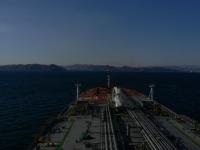
What will 2030 look like for the marine industry as such forces as population change, shifts in economic activity, the demand and allocation of resources and the impact of the environment gather momentum and transform the world around us? Global Marine Trends 2030 has been prepared by Lloyd’s Register’s Strategic Research Group, QinetiQ and the University of Strathclyde.
Three scenarios for the future of marine fuels:
– Report indicates that in all scenarios heavy fuel oil remains the main fuel for deep sea shipping; LNG develops a deep sea bunker market share of 11%; low sulphur heavy fuel oil and hydrogen emerge as alternatives in certain scenarios
– In Global Commons, the most optimistic scenario for a more sustainable world, global greenhouse gas emissions from shipping decline from 2025 despite significant growth in shipping
– Study shows that the combination of growth in trade and reduced emissions would require a reduction in fossil fuel dependency and the commencement of a transition to a zero carbon fuel like hydrogen
Global Marine Fuel Trends 2030 released by Lloyd’s Register provides insight into future fuel demand for the containership, bulk carrier/general cargo and tanker sectors - representing approximately 70% of the global shipping industry’s fuel demands.
Shipping is the enabler of world trade – if world trade grows then so will seaborne tonne miles of cargo. The GMT 2030 report issued last year indicates we can expect strong growth for shipping. With emissions regulations and rising energy costs, shipping decision makers will benefit from a clearer understanding of the potential scenarios for marine fuel demand.
The three scenarios are:
Status Quo – The world will continue its current growth momentum with some booms and busts over the next twenty years.
Global Commons – A shift to concern over resource limitation and environmental degradation will see a desire for a more sustainable world being developed and fairness in wealth distribution. Governments will find common ground and accelerated economic growth, within a framework of sustainable development, which will follow.
Competing Nations – States act in their own national interest. There will be little effort to forge agreement amongst governments for sustainable development and international norms. This is a self-interest and zero-sum world with a likely rise in protectionism and slower economic growth.
So what does the marine fuel mix look like for containers, bulk carriers and tankers by 2030? In two words: decreasingly conventional. Heavy fuel oil (HFO) will still be very much around in 2030, but in different proportions for each scenario: 47% in Status Quo, to a higher 66% in Competing Nations and a 58% share in Global Commons, the most optimistic of scenarios for society. A high share of HFO, of course, means a high uptake of emissions abatement technology when global emissions regulations enter into force.
The declining share of HFO will be offset by low sulphur alternatives (MDO/MGO or LSHFO) and by LNG, and this will happen differently for each ship type and scenario. LNG will reach a maximum 11% share by 2030 in Status Quo. Interestingly, there is also the entry of Hydrogen as an emerging shipping fuel in the 2030 Global Commons scenario which favours the uptake of low carbon technologies stimulated by a significant carbon price.
You can find full report here: https://dl.dropboxusercontent.com/u/110796764/gmt2030/index.html
Wach You Tube video here: http://www.youtube.com/watch?v=BChkVfqe7fo
![[ad-side]](http://www.crewing24.com/ad_images/77_banner.gif)
![[ad-side]](http://www.crewing24.com/ad_images/110_banner.png)
![[ad-side]](http://www.crewing24.com/ad_images/89_banner.png)
![[ad-side]](http://www.crewing24.com/ad_images/85_banner.jpg)
![[ad-side]](http://www.crewing24.com/ad_images/93_banner.jpg)
![[ad-side]](http://www.crewing24.com/ad_images/80_banner.jpg)
![[ad-side]](http://www.crewing24.com/ad_images/79_banner.jpg)
![[ad-side]](http://www.crewing24.com/ad_images/103_banner.jpg)
![[ad-side]](http://www.crewing24.com/ad_images/95_banner.gif)
![[ad-side]](http://www.crewing24.com/ad_images/115_banner.jpg)